You’ll achieve dramatically better miniature quality with resin printing due to its superior 0.05mm resolution compared to FDM’s 0.1-0.3mm range. Resin captures intricate facial expressions, tiny accessories, and complex geometries while delivering smooth surfaces that require minimal post-processing. You’ll experience higher success rates over 90%, dimensional accuracy essential for gaming compatibility, and excellent support for overhangs and delicate structures. The enhanced detail quality and reduced failure rates make the investment worthwhile for serious miniature creators seeking professional results.
Superior Detail Resolution for Miniature Features
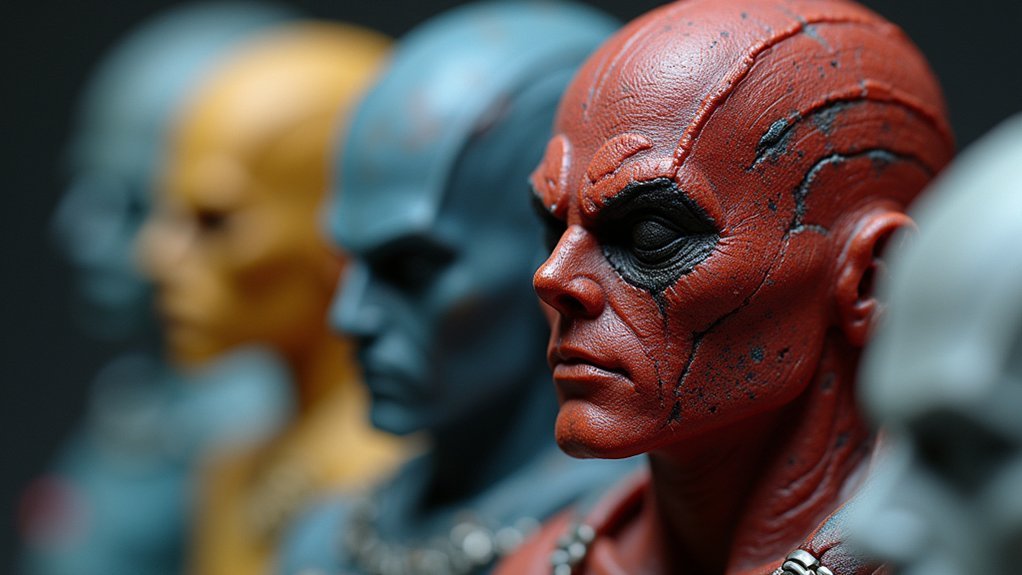
When you’re crafting miniatures that demand exceptional detail, resin printers deliver resolutions as fine as 0.05 mm—a precision level that FDM technology simply can’t match. Popular models like the Anycubic Photon and Elegoo Mars showcase this capability, capturing intricate facial expressions and tiny accessories that would appear blurred or missing on FDM prints.
Resin printing’s layer exposure method creates remarkably smooth surfaces with sharp, defined features. You’ll notice the difference immediately—fewer visible layer lines and superior aesthetic quality compared to traditional FDM output.
This technology enables complex geometries and delicate structures that FDM printers struggle to reproduce accurately. When your miniatures require fine details that truly showcase craftsmanship, resin printing provides the resolution necessary to bring your vision to life.
Smooth Surface Finish Reduces Post-Processing Time
You’ll notice resin prints emerge from the printer with remarkably smooth surfaces that showcase superior detail resolution without the visible layer lines that plague FDM prints.
This inherent smoothness means you won’t spend hours sanding away imperfections to achieve a professional finish.
The glossy, refined surface quality straight from the build plate dramatically cuts your post-processing time, letting you move quickly from printing to painting your miniatures.
Superior Detail Resolution
Precision defines resin printing’s greatest advantage over FDM when creating miniatures.
You’ll achieve resolution as fine as 0.05 mm with resin 3D printers, dramatically outperforming FDM’s typical 0.1 mm to 0.3 mm layer heights. This superior resolution means you can reproduce intricate details like facial features, tiny accessories, and complex textures that would be impossible with FDM technology.
When you’re printing highly detailed models, resin captures every nuance your design contains.
Small weapon details, armor textures, and character expressions come through clearly without the stepped appearance common in FDM prints. You’ll notice the difference immediately when examining fine elements like chain mail, jewelry, or facial hair.
This level of detail reproduction makes resin the clear choice for miniatures requiring exceptional accuracy and visual appeal.
Minimal Layer Lines
Since resin printers operate at ultra-fine layer heights, they produce virtually invisible layer lines that create an exceptionally smooth surface finish.
You’ll achieve layer heights as fine as 0.05 mm, dramatically surpassing FDM’s typical 0.1 mm to 0.3 mm range. This superior surface quality means your miniatures emerge from resin printers ready for painting or display immediately after curing.
You won’t need extensive sanding or filling like you’d with FDM prints that show obvious layer lines. The sleek appearance requires minimal manual intervention, saving you significant time and effort.
Fine textures and intricate designs remain crisp and clear, enhancing your miniatures’ visual appeal. This streamlined workflow lets you focus on creativity rather than tedious post-processing work.
Less Sanding Required
The difference becomes immediately apparent when you compare finished prints side by side. Resin printing delivers exceptional surface quality that eliminates most sanding requirements, while FDM prints demand extensive post-processing to achieve comparable results.
| Processing Stage | Resin Printing | FDM Printing |
|---|---|---|
| Initial Finish | Smooth, detailed surface | Visible layer lines |
| Sanding Required | Minimal to none | Multiple grits needed |
| Time Investment | Focus on painting/detailing | Hours of preparation |
| Final Quality | Professional appearance | Requires skill to match |
With resolutions reaching 0.05 mm, resin prints emerge from the printer nearly ready for painting. You’ll spend considerably less time preparing miniatures and more time on creative aspects like painting and customization, maximizing your hobby enjoyment.
Dimensional Accuracy for Gaming Compatibility
When you’re crafting miniatures for tabletop gaming, achieving dimensional accuracy isn’t just about aesthetics—it’s about functionality. Resin printers deliver resolutions as high as 0.05 mm, guaranteeing your miniatures meet the precise standards required for competitive gaming compatibility.
This superior dimensional accuracy means your pieces will fit together seamlessly during gameplay, eliminating frustrating assembly issues that can disrupt your gaming experience.
Unlike FDM printers that produce visible layer lines and rougher surfaces, resin printing captures every intricate detail—from facial features to weapon accessories—with remarkable precision.
You’ll spend less time on post-processing while achieving miniatures that maintain professional gaming standards. The smooth surface finish not only enhances visual appeal but also guarantees better paint adhesion, making your miniatures tournament-ready.
Complex Geometry Support for Intricate Designs
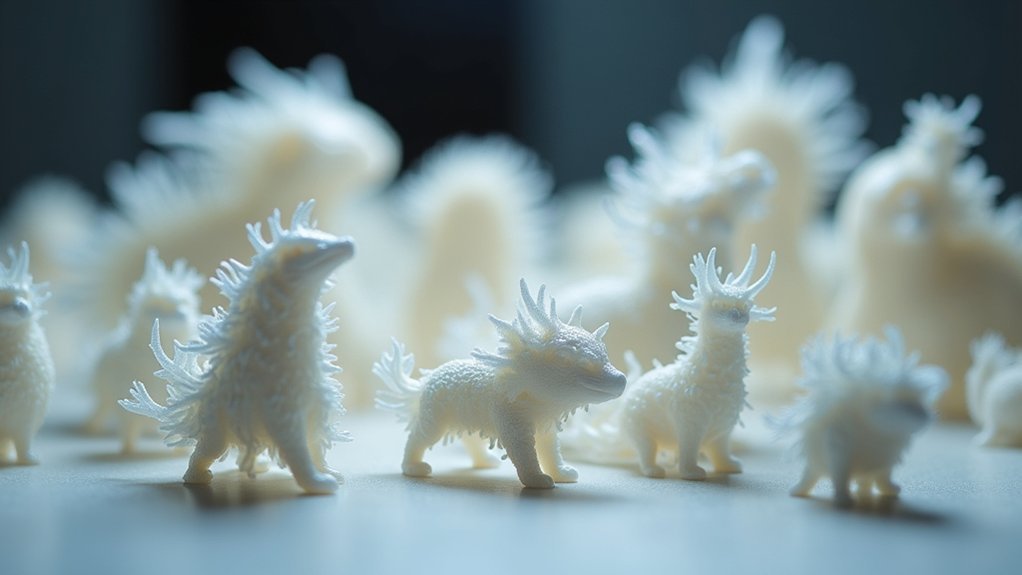
Beyond achieving precise dimensions, resin printing transforms how you approach miniatures with complex architectural elements and organic curves. Your resin printer excels at creating intricate internal structures and dramatic overhangs without requiring extensive support systems that typically plague FDM printing.
| Feature | Resin Result | Your Experience |
|---|---|---|
| Fine Details | 0.05mm resolution | Crisp facial expressions |
| Overhangs | No support needed | Perfect armor plates |
| Internal Geometry | Hollow structures | Lightweight, detailed models |
| Surface Quality | Smooth finish | Professional appearance |
The layer curing process preserves delicate accessories and complex geometries that FDM printers simply can’t match. You’ll notice intricate textures remain sharp, while organic curves flow naturally without visible layer lines. This capability lets you tackle ambitious designs previously impossible with traditional printing methods.
Layer Line Elimination for Professional Quality
When you examine a resin-printed miniature, you’ll notice the absence of visible layer lines that typically plague FDM prints.
This smooth surface finish creates a professional appearance that’s immediately apparent to anyone handling your models.
You won’t need to spend extra time sanding or smoothing surfaces since resin printing naturally eliminates the stepped texture that mars FDM miniatures.
Smooth Surface Finish
One glance at a resin-printed miniature reveals the most compelling reason to choose this technology over FDM: the remarkably smooth surface finish that eliminates those telltale layer lines plaguing traditional filament printing.
With resin 3D printing, you’ll achieve professional-quality results that require minimal post-processing effort. Your miniatures emerge from the printer with surfaces so smooth they’re immediately ready for painting and display.
Unlike FDM prints that demand extensive sanding and finishing work, resin prints deliver that coveted professional aesthetic straight from the build plate. This superior surface quality means you’ll spend less time preparing your miniatures and more time enjoying them.
The smooth finish also enhances paint adhesion and coverage, ensuring your finished pieces look truly exceptional.
Invisible Layer Lines
The secret behind that smooth surface finish lies in resin printing’s ability to eliminate layer lines entirely, creating an almost injection-molded appearance that’s impossible to achieve with FDM technology.
You’ll notice that invisible layer lines are resin printing’s greatest advantage when crafting miniatures. While FDM prints typically show visible stepping at 0.1-0.3mm layer heights, resin achieves remarkable 0.05mm resolution that eliminates these artifacts completely.
This precision transforms your miniatures into professional-quality pieces that rival commercially manufactured figures.
You won’t need extensive post-processing to hide ugly layer lines like you’d with FDM prints. Instead, you’ll get seamless surfaces straight from the printer that enhance every detail, from facial features to weapon textures, making your tabletop gaming pieces truly stand out.
Fine Feature Reproduction for Weapons and Accessories
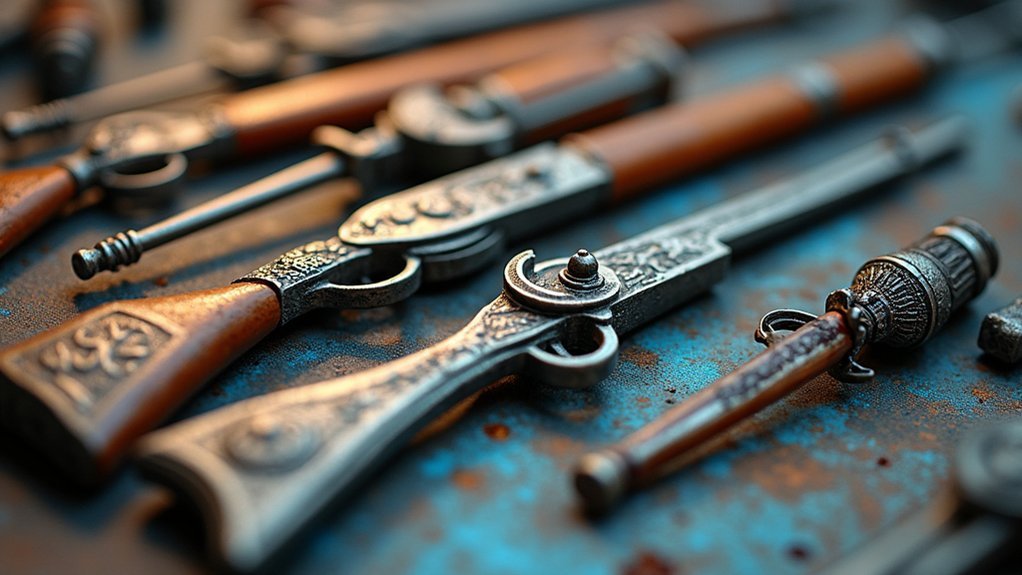
Intricate sword hilts, delicate crossbow mechanisms, and ornate armor details demand precision that resin printing delivers with exceptional clarity.
When you’re printing miniature weapons and accessories, every tiny grip texture, decorative pattern, and mechanical component matters for both aesthetics and gameplay immersion.
Your resin 3D printer captures details as fine as 0.05 mm that FDM simply can’t reproduce. Those small weapon engravings, delicate chain mail links, and intricate bow strings that would appear as blobs on FDM prints emerge crisp and defined with resin technology.
You’ll notice how tiny buckles, ornate crossguards, and weapon pommels maintain their intended design integrity.
This precision makes your tabletop characters more visually striking and authentic-looking, enhancing the overall gaming experience through superior detail reproduction.
Material Properties Optimized for Small Scale Printing
Photopolymer resins possess unique chemical characteristics that make them exceptionally suited for miniature production at small scales.
When you’re working with miniatures, the liquid nature of photopolymer resins allows you to capture complex geometries and undercuts that FDM’s filament extrusion simply can’t handle. The material’s density gives you ideal weight distribution, guaranteeing your detailed designs maintain structural integrity without becoming fragile.
Resin printing delivers layer thicknesses as fine as 0.05 mm, enabling you to achieve intricate details that would be impossible with FDM.
You’ll find the superior surface finish quality eliminates the extensive post-processing typical of FDM prints. The chemical properties guarantee tiny weapons, facial features, and delicate accessories retain their precision, giving you professional-quality miniatures straight from the printer.
Printing Speed Advantages for Detailed Models
When you’re printing detailed miniatures, resin’s faster layer curing times give you a significant speed advantage over FDM printing.
You’ll complete intricate designs in under 7 hours compared to FDM’s 14+ hour print times for similar complexity.
You can also maximize efficiency by batch printing multiple miniatures simultaneously, since the UV light cures entire layers at once regardless of how many models fill the build plate.
Faster Layer Curing
While FDM printers methodically extrude filament layer by layer, resin printers cure entire layers almost instantaneously using UV light, creating a considerable speed advantage that’s especially pronounced for detailed miniatures.
This faster layer curing mechanism transforms your printing workflow. You’ll achieve layers as fine as 0.05 mm without sacrificing speed, unlike FDM printers that require thicker layers for faster prints. The instantaneous UV curing process means you’re not waiting for plastic to slowly build up—entire layers solidify simultaneously.
- Reduced print failures: Faster layer curing minimizes opportunities for errors during the printing process
- Consistent quality: Each layer cures completely before the next begins, ensuring reliable detail reproduction
- Efficient batch printing: You can produce multiple detailed miniatures in notably less time than FDM methods
Batch Printing Efficiency
Beyond the speed of individual layer curing, resin printing delivers remarkable batch efficiency that fundamentally changes how you approach miniature production.
You can print multiple highly detailed miniatures simultaneously in a single batch, maximizing your build volume utilization. This batch printing efficiency means you’ll complete entire armies or collections in under 7 hours, compared to 14+ hours for equivalent FDM prints.
The streamlined post-processing further enhances efficiency. Your resin miniatures emerge with smoother surface finishes, requiring minimal sanding compared to FDM prints.
You’ll spend less time on individual setups and adjustments since each batch handles multiple models at once. When comparing FDM and resin for miniature production, resin’s ability to produce numerous intricate pieces simultaneously while maintaining exceptional detail makes it the superior choice for hobbyists and professionals alike.
Build Volume Efficiency for Multiple Miniatures
Maximizing your resin printer’s build volume transforms small print areas into productive powerhouses for miniature creation.
While resin printers offer smaller build volumes than FDM machines, you’ll achieve superior build volume efficiency by strategically arranging multiple detailed miniatures within each print job.
Your resin printer’s layer-by-layer curing process preserves intricate details across all miniatures simultaneously, maintaining quality throughout batch production.
Resin printing’s simultaneous curing technology ensures every miniature in your batch maintains identical precision and detail quality throughout production.
You’ll complete larger projects without constant pausing and resetting, creating a streamlined workflow that maximizes productivity.
- Strategic arrangement: Pack multiple miniatures efficiently without compromising 0.05mm resolution detail
- Simultaneous quality: Maintain consistent detail across all models in a single print job
- Faster completion: Quick layer curing reduces overall batch printing times compared to FDM
Support Structure Performance With Delicate Parts
When printing delicate miniature components like thin weapon blades or fragile wing details, resin’s liquid state flows seamlessly around intricate geometries to create precisely positioned supports that won’t compromise your model’s finest features.
You’ll achieve superior support structure performance because resin supports can be much thinner than FDM’s solid plastic alternatives, making removal cleaner without damaging delicate areas.
Resin printers let you generate complex support geometries that minimize contact points with your miniature, reducing surface blemishes considerably.
The UV curing process maintains higher dimensional accuracy throughout printing, preserving delicate feature integrity.
Unlike FDM supports that can cause warping from cooling stresses, resin supports reliably maintain your model’s fidelity while protecting even the most fragile components during the entire printing process.
Color and Finish Options for Enhanced Detail
The exceptional surface quality of resin printing reveals a spectrum of color and finish possibilities that’ll transform your miniatures into showcase pieces.
You’re no longer limited to basic FDM filament colors – resin’s diverse palette lets you create vibrant, visually striking miniatures straight from the printer.
The smooth 0.05 mm resolution surfaces eliminate visible layer lines, making painting effortless while preserving intricate details like facial expressions and armor textures.
Your color and finish options for enhanced detail extend beyond standard materials too.
Consider these specialty resin advantages:
- Flexible resins create bendable weapons and accessories that won’t break during gameplay
- Translucent resins produce magical effects like glowing crystals or ethereal spirits
- Metallic finishes deliver realistic armor and weapon appearances without additional painting
Print Failure Rates and Success Consistency
Beyond aesthetic advantages, resin printing delivers remarkable reliability that’ll save you time and materials.
When you’re creating intricate miniatures, resin printers achieve success rates exceeding 90% with proper calibration, while FDM printers struggle with print failure rates reaching 10-30% for similar complexity.
You’ll experience fewer issues because resin’s layer-by-layer curing process eliminates common FDM problems like warping, under-extrusion, and adhesion failures.
The precision of resin printing means each layer solidifies exactly as intended, preventing the misalignment that plagues detailed FDM prints.
You’ll also benefit from shorter print times that enable quicker iterations and adjustments.
Since resin produces smoother surfaces with finer details straight from the printer, you’ll spend less time fixing post-processing issues that frequently occur with FDM miniatures.
Cost Analysis for Miniature Production Workflows
Although resin printers offer superior quality, you’ll face markedly higher material costs that can dramatically impact your miniature production budget. The cost of the resin ranges from $30 to $150 per liter, substantially exceeding FDM filament’s $20-30 per kilogram price point.
You’ll also need additional expenses for post-processing materials like isopropyl alcohol and UV curing stations.
However, several factors can offset these higher costs:
Higher material costs can be offset by faster production times, superior detail quality, and reduced waste from fewer failed prints.
- Faster print times – Complex miniatures often complete in under 7 hours, saving valuable production time
- Superior detail quality – The exceptional finish quality increases your miniatures’ market value and desirability
- Reduced waste – Higher success rates mean fewer failed prints and less material waste
While initial material costs are steeper, resin printing can deliver better long-term value through quality and efficiency gains.
Frequently Asked Questions
Is Resin or Filament Better for Miniatures?
You’ll get better miniature results with resin since it achieves 0.05mm resolution compared to filament’s 0.1-0.3mm range. Resin produces smoother surfaces and captures intricate details like weapons and wings that filament can’t replicate.
Is FDM Better Than Resin?
FDM isn’t better than resin for miniatures. You’ll get visible layer lines, struggle with fine details, and spend more time post-processing. Resin delivers superior surface quality and captures intricate features you can’t achieve with FDM printing.
Why Resin for Miniatures?
You’ll get incredibly sharp details with resin printing that FDM can’t match. Facial features, textures, and tiny elements come out crisp at 0.05mm resolution, perfect for tabletop miniatures.
What Are the Downsides of a Resin 3D Printer?
You’ll face higher resin costs, toxic fumes requiring ventilation, complex post-processing with alcohol cleaning and UV curing, smaller build volumes, and steeper learning curves with exposure settings.

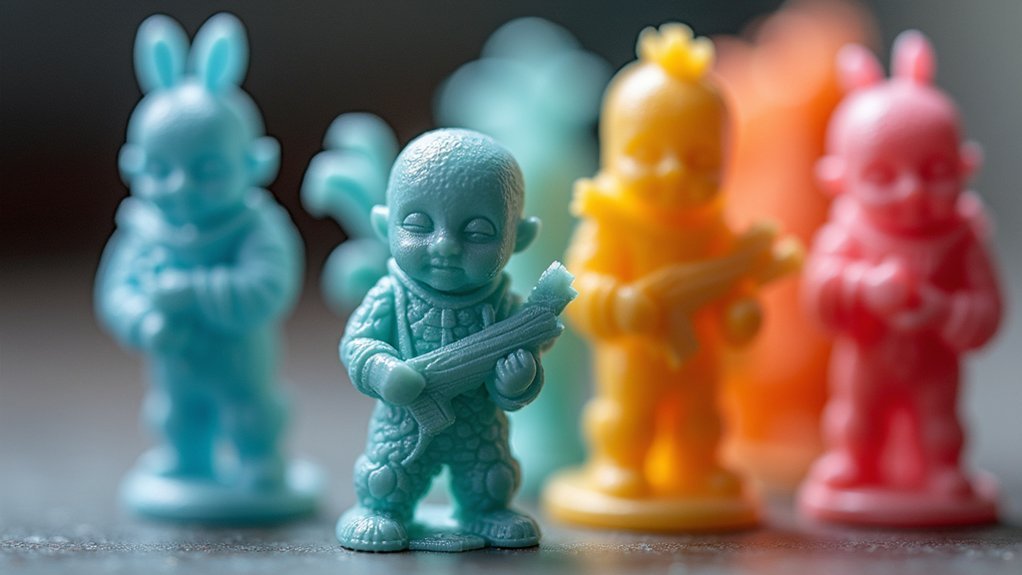
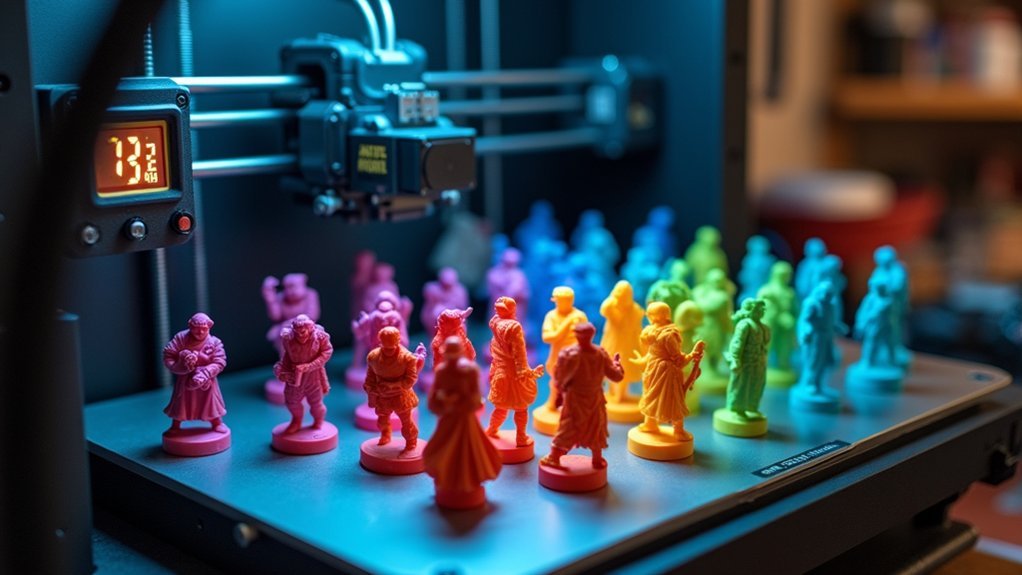
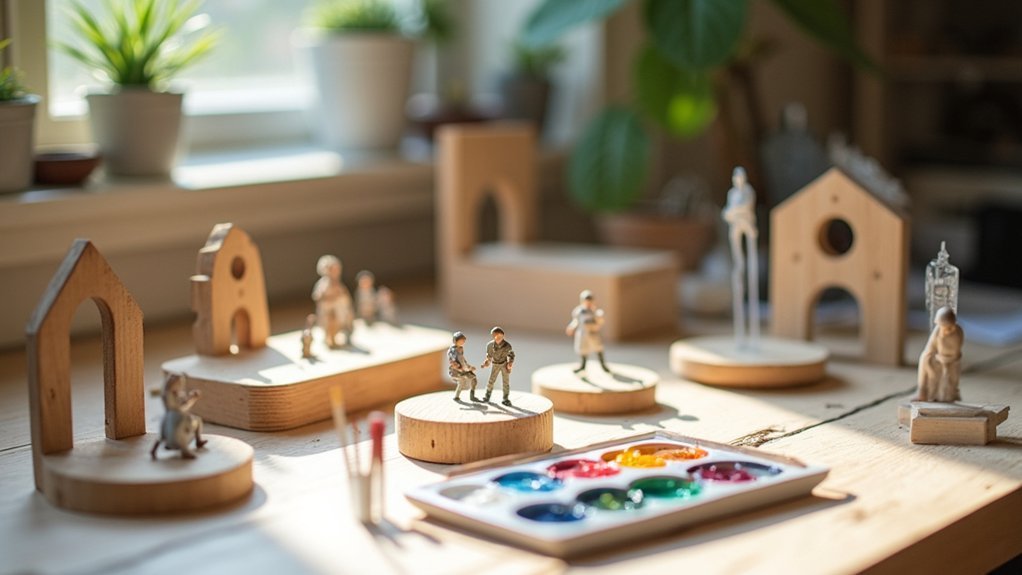
Leave a Reply